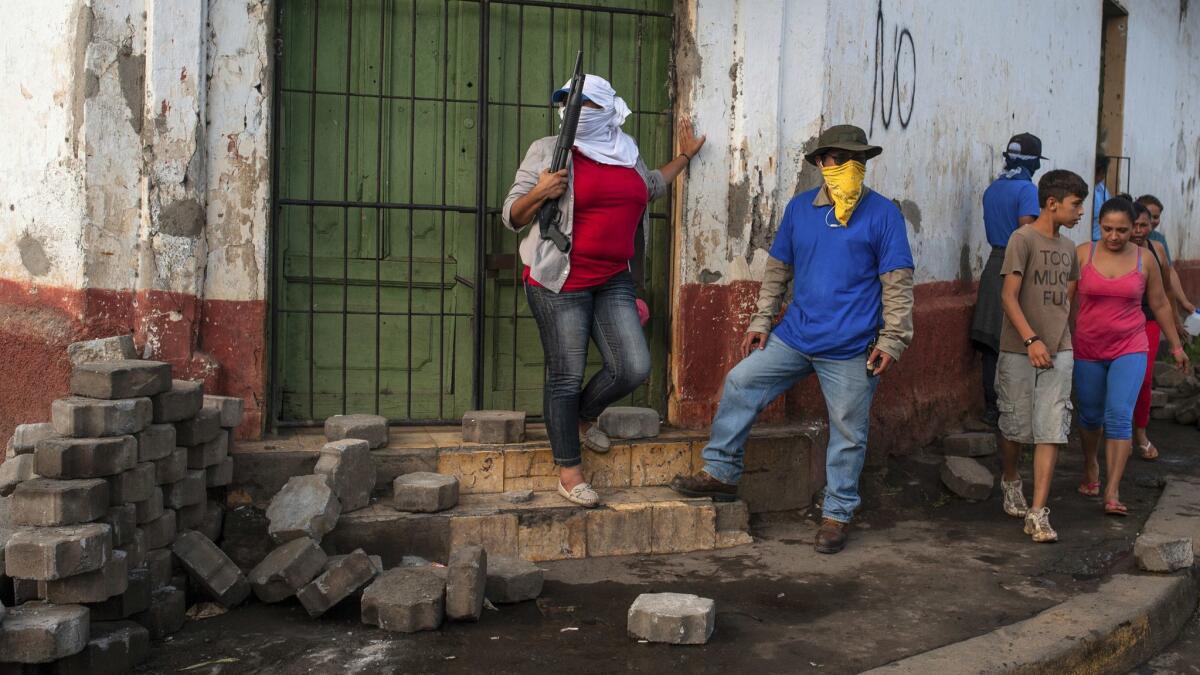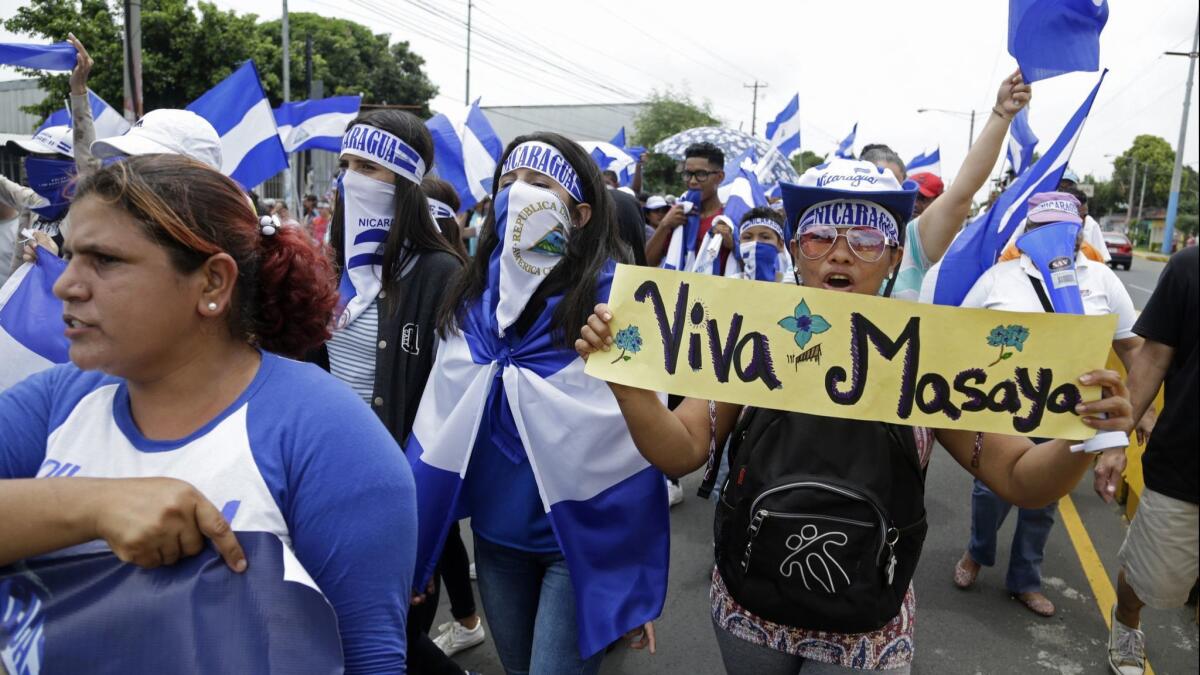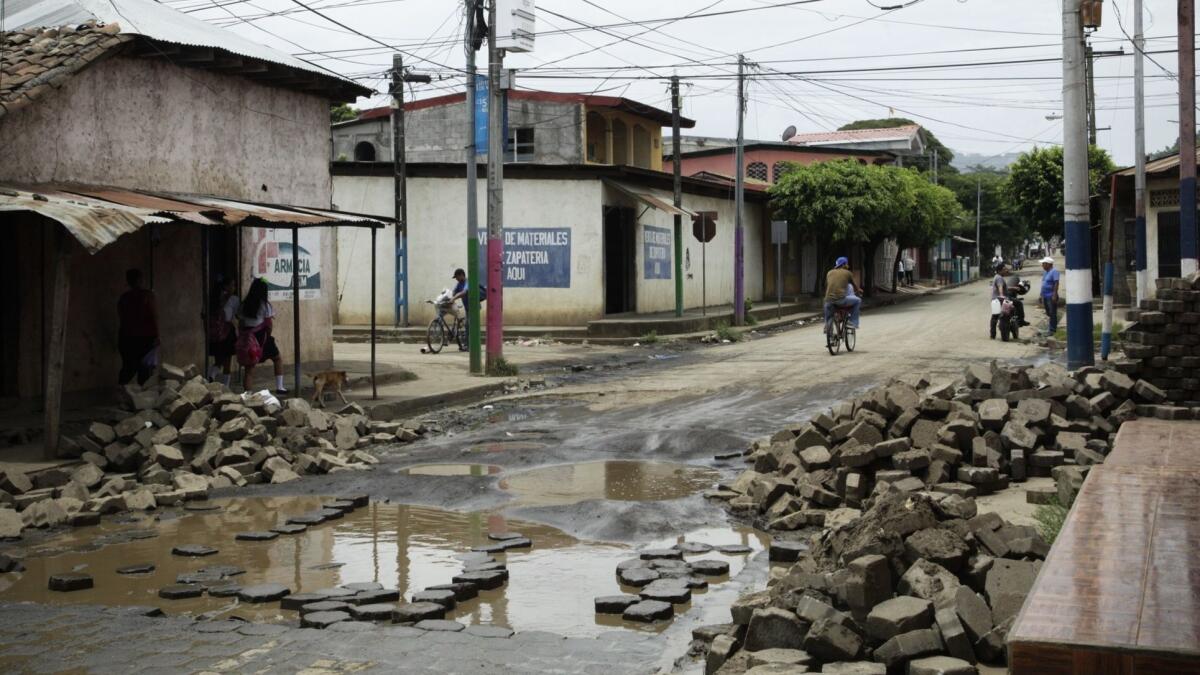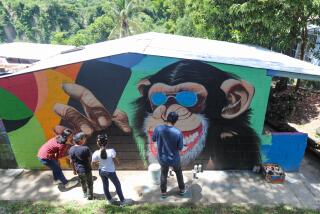A Nicaraguan city became famous as a rebel stronghold. Now it has turned against the Sandinistas it once backed

Reporting from Masaya, Nicaragua — The barricades have come down, the masked insurgents have vanished, and an edgy sense of calm has returned to the streets.
Red-and-black banners of the ruling Sandinista front are ubiquitous, as the federal government has regained control of this volcano-rimmed town, about 15 miles southeast of Managua, the capital.
Still, plentiful graffiti denounce the front’s leader — President Daniel Ortega — as a “murderer” and “dictator,” among other, earthier epithets. Signs spray-painted on walls warn against the ever-present sapos — literally, toads — the vernacular here for informers, loyalists to Ortega and his Sandinista government. When visitors come to Masaya, wary eyes monitor them.
On a recent day, residents gathered outside homes to chat in the stifling heat about their proud city. Masaya was long celebrated for its revolutionary past, but now has emerged as an emblem of what some are calling the “new” Nicaraguan revolution of 2018.
“This is not over,” vowed one anti-government militant, Jorge, 26, who said he was on the run from police and declined to provide his last name for security reasons. “We have just seen the beginning,” Jorge added, gazing suspiciously at passersby as he spoke in a lush park overlooking the majestic tableau of the Masaya Lagoon. “We will be back.”
This is the fragile scenario today in Masaya, Nicaragua’s picturesque “City of Flowers,” the country’s handicrafts and folklore hub — and a bastion of the Sandinista revolution that ousted dictator Anastasio Somoza almost 40 years ago. Ortega was then a young commander of the Sandinista brigades, a dedicated fighter who had survived Somoza’s prisons.
Before the final victory in July 1979, Sandinista guerrillas reeling from government bombardment in the Managua area fell back to Masaya in a “tactical withdrawal” that is now celebrated in revolutionary lore.
Ortega and his wife, Rosario Murillo, the vice president, in the past marked the anniversary of the maneuver before cheering crowds while traveling in a bus with family members along the route of the retreat. Even Ortega, now 72, never known for his charisma or oratory skills, seemed to savor the event, basking in the sense of public acclaim for a historic triumph in which Masaya played a heroic role.
There was no such celebration this year, however.
For weeks, several Masaya districts — especially the central Monimbo neighborhood and adjacent San Miguel area — became fortified citadels of resistance to Ortega’s government. Militants pried paving stones from the ground and piled them into barricades, effectively blocking police advances. Police stations were besieged.
Anti-government militants, some armed, often with homemade mortar launchers, most wearing handkerchiefs to conceal their identities, manned the blockades. Masaya, they proclaimed, no longer recognized the legitimacy of Ortega’s government.
Pro-government forces mounted an offensive and retook the disputed districts in mid-July, amid heavy fighting. Police arrested scores. The opposition says some three dozen protesting civilians have been killed in Masaya, many by government snipers, since the conflict erupted in April.
Among the victims, the opposition says, was Alvaro Alberto Gomez, 23, a finance student at the National Autonomous University of Nicaragua shot in the chest and killed on April 20 in the Monimbo district.
“What bothers me most is the way they killed my son,” said Gomez’s father, Alvaro Gomez Sr., 48, who lost his right foot fighting as a Sandinista solider in the 1980s war against the U.S.-backed Contra forces. “My son had a stick, a stone, but the person who shot him was different: He had a rifle, a pistol.”
More than three months of violence and political turmoil have convulsed this Central American nation of 6 million, leaving some 300 dead nationwide, according to human rights and opposition groups. Opponents are demanding the resignation of the president. Critics accuse Ortega, who has served as president for more than 11 consecutive years, of autocratic, dictatorial rule. The revolutionary leader, opponents charge, has betrayed the revolution.
Ortega refuses to step down and accuses the opposition of engaging in a “satanic” campaign to kill police and government loyalists. The one-time global leftist icon has blamed his longtime adversary, Washington, for fomenting violent opposition to his administration, a strong ally of U.S. antagonists Cuba and Venezuela.
The government says that many police and others loyal to the leadership also were killed during the unrest in Masaya.

For the time being, at least, Masaya is back in government hands. On the streets, workers in blue smocks gather up the piles of paving stones, known as adoquin, that the opposition used to erect barriers. Small bulldozers aid in the tedious cleanup process.
On occasion, pickups filled with plainclothes, armed government security forces — referred to as paramilitaries — rumble down the streets. Some suspects picked up in large-scale sweeps that accompanied the government offensive here could face terrorism charges under new laws passed by the national legislature.
In recent days, relatives of some of those detained in Masaya have gathered outside the city jail downtown. They are a forlorn group seeking any word on the fate of their loved ones.
“We have no idea why he was taken prisoner,” said Jose Cristobal Davila, referring to his incarcerated nephew, Marlon Davila Sotano, 34.
According to his family, Davila Sotano was arrested by security forces as he participated in a pro-government rally on July 19. He is a refrigerator repairman and is a supporter of Ortega, the family said.
“We don’t get it,” the uncle said. “My nephew is a militant Sandinista.”
Relatives of the detained assailed what they labeled unjust arrests. Police went house-to-house during “Operation Cleansing” in an effort to round up anti-government ringleaders. But many opposition militants are reported to have fled the town and gone underground.
“They are arresting everybody, without even investigating to see if they committed any crime,” complained Eveling Sofia Moreno Espinoza, who was also among those waiting outside the jail.
She said her brother, Francisco Moreno Espinoza, 42, who owns a handicrafts shop outside town, was arrested on suspicion of being part of the revolt. His family says he had nothing to do with it.
“My brother is a simple artisan,” his sister said.
Down the street from the jail, the church of Saint Miguel remained shuttered on a recent Sunday. The parish priest here became well known for having provided shelter in his church to wounded protesters. Some say the priest, too, is on the run.
The Roman Catholic Church has denied allegations by Ortega that churches were used as bases for armed gangs.

Some shops in once-barricaded areas are finally opening their doors.
“I had to close my place for two months because of the violence and insecurity,” said Alex Espinoza, who just reopened his pizza kiosk in the plaza in front of the San Miguel church.
The neighborhood, usually bustling on weekends, had a ghost-town vibe. There was little traffic, few people in the plaza.
“We all want peace,” said Socorro Poveda, 43, a mother of five who reopened her corner clothing emporium the other day after weeks of being closed. “But there is still a great sense of insecurity. You can feel it in the streets. Hopefully, though, real peace will come soon.”
But signs of the recent unrest are inescapable. Bullet holes sprinkle some buildings around town. A few structures were burned. Many homes and stores remain vacant, the owners and residents having fled. And giant potholes mar streets where the paving stones were yanked from the ground to be employed as raw materials for barricades.
Many roadway stones are now piled vertically at strategic sites, in columns 6 feet or more in height. These have become makeshift sentry posts, mini-forts in the midst of town. Armed government security men are ensconced in the shelters, peeking out through openings at the desultory cityscape of Masaya, where friend and foe are no longer so easily discernible.
Special correspondent Wilfredo Miranda in Masaya contributed.
Twitter: @PmcdonnellLAT
More to Read
Sign up for Essential California
The most important California stories and recommendations in your inbox every morning.
You may occasionally receive promotional content from the Los Angeles Times.










